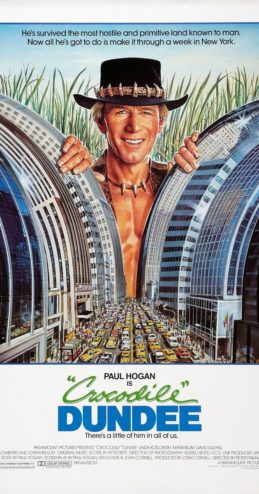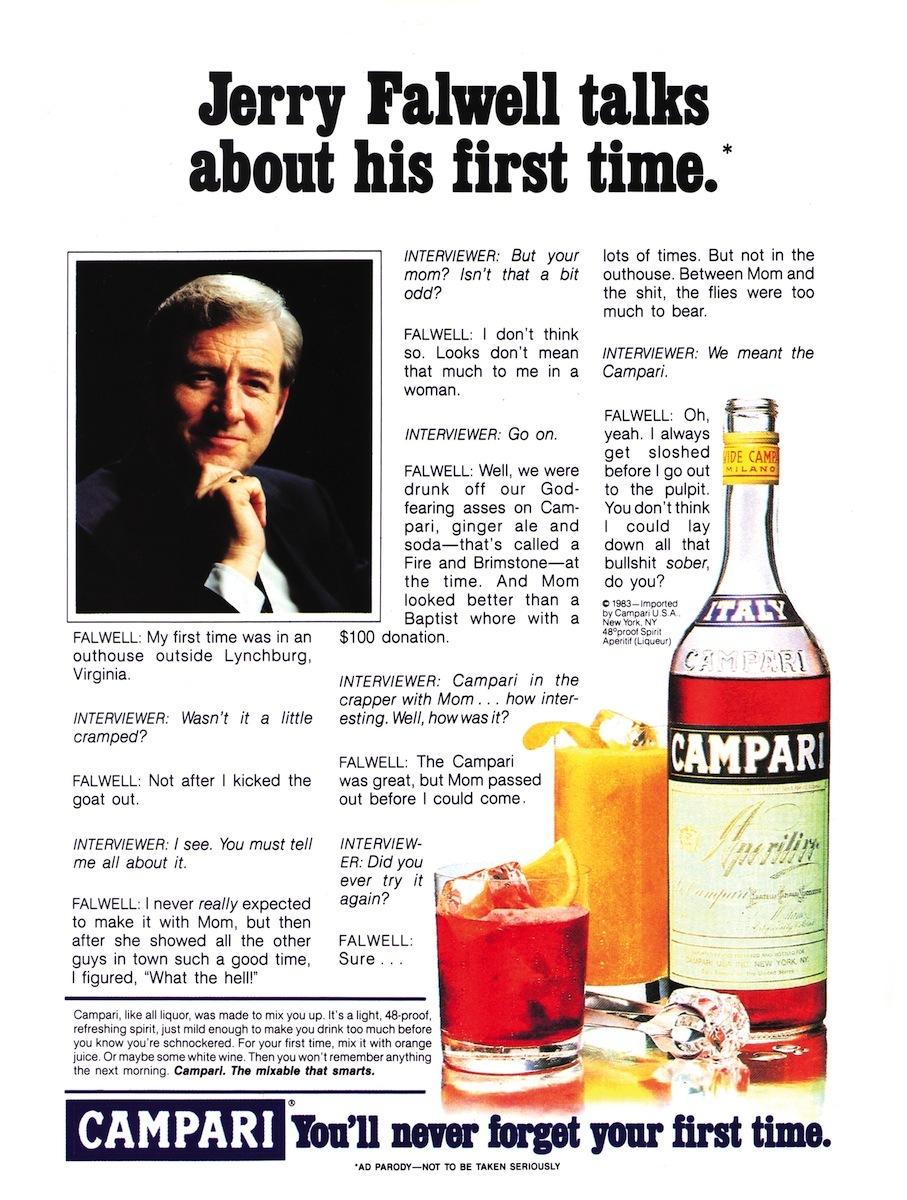As a parent, one of the things we encourage our children to do is to take in entertainment from various time periods, including books, music, and movies. One of the older films we watched recently was the 1986 film Crocodile Dundee, a comedy featuring an Australian man from the Outback and the female news reporter from New York City who shares adventures with him. Viewing the film after 30 years, it also features a laundry list of stereotypes from the mid-1980’s, including the stereotypes of the Hispanic maid, the affluent New Yorkers and their high style of living, and African-Americans as either chauffeurs or gang members. The three strongest of the stereotypes featured were the perceptions of 20th century Australians, the “fish out of water” trope, and the view of transgendered people at the time.
A Summary of Crocodile Dundee
Crocodile Dundee began with New York City reporter Sue Charlton (Linda Kozlowski) traveling to the Outback of Australia, to interview hunter and safari owner Mick ‘Crocodile’ Dundee (Paul Hogan). Charlton is writing several feature stories about Dundee for her newspaper, especially about the time that he was nearly killed by a crocodile while out hunting. Dundee takes her through the area in the Outback where the event happened, with a bond gradually growing between the two. Charlton is a headstrong woman, but begins to rely on masculine, tough Dundee, as her city ways make her unaccustomed to harsher life in the Outback. After hiking through the Outback, Charlton asks Dundee if he will come back to New York with her, which he accepts.
In the second half of the film, Dundee has several adventures through New York City, as Charlton and Dundee swap places as the “fish out of water.” Most of those adventures are with Dundee, and reinforced the stereotype of the simpler man in a more sophisticated society. Charlton and her family are a part of high society, contrasted by the more rugged nature of Dundee, and she has to fight her feelings between her fiance and Dundee. In the end, she ends her engagement, runs to Dundee, and, in a somewhat famous scene, meets him after he walks over the top of all of the people on a crowded subway platform2.
The film was immensely successful, not only breaking into the American film market and succeeding with two sequels, but it helped to start the Australian craze of the late 1980’s. In adjusted dollars, Crocodile Dundee’s $393,000,000 box office still ranks at number 122 of the highest grossing films domestically in history, higher than hits like Saving Private Ryan, Harry Potter and the Chamber of Secrets, and 2016’s blockbuster Deadpool1. The stereotype of the tough man from the harsh Outback, and other Australian stereotypes, were popularized by the film due to its strong showing in the U.S.6 The stereotypes have been hard for Australians to shake, parodied in cultural media from The Simpsons to films like Dumb and Dumber and Deadpool.
Australian “Man Down Under” Stereotype
The stereotype of the adventurous and tough, yet uncivilized Australian man is one that Crocodile Dundee made popular worldwide, and as other cultural media show it is a stereotype that continues to exist 30 years later. Countries are often perceived based on symbols and characters, and popular media is a robust method of ingraining a sense of a society on to another one3. Film offers a powerful image of a culture, molding how Americans see the culture of Australia and symbolizing, in truth or not, what the people of Australia are like3. The popularity of the film, and the rugged portrayal of Mick Dundee, enforces the idea that Australians are a tough people, fighting to live a hard, uncivilized way of life in a hostile country.
The stereotype cannot possibly offer a view of every member of Australian society, and is viewed as outdated by some in the country. Australians see the stereotype as very limited, an inaccurate and antiquated vision of who the people of Australia really are6. Dundee defined the Australian stereotype as always very masculine, a perfect shot with a rifle, can track and find his way through any type of land or harsh condition, and can drink anyone under the table. But Australia, like most countries, has many microcultures within it. From the aboriginal people, to those who emigrated from Great Britain and other parts of the former British empire, to modern immigrants from Asia, Australia is a mixing pot of varying cultures. In the film, the Australian stereotype is mostly seen as a curiosity. In several scenes, the upper-class people of New York City treat him more as a spectacle, someone to have fun watching instead of someone that fits within the microculture of their affluent society.
 “Fish Out of Water” Stereotype
“Fish Out of Water” Stereotype
Stories have been told for hundreds of years about the proverbial “fish out of water,” characters who find themselves in different cultures and situations, without any knowledge of what to do or where they are going. Mary in The Secret Garden, Bilbo Baggins in The Hobbit, and Gulliver himself from Gulliver’s Travels all fit the stereotype of the character lost in an unfamiliar place, often considered simple-minded by those around him.
While Charlton’s time in the Outback during the first half of Crocodile Dundee generally highlighted the trope, Mick Dundee’s time in New York City defined the “fish out of water” stereotype. There are similarities with 1942’s Tarzan’s New York Adventure, where the main character is perplexed by the modernity of the city4. Dundee is mystified by the escalator in the airport, and what the bidet in his hotel room is supposed to do. He sleeps on the floor instead of the strange bed, and is fascinated by the hotel’s revolving door. The stereotype is not necessarily about someone who lacks intelligence, but, as Dundee fits it, someone who simply is out of touch with the peculiar culture around him.
Dundee finds several microcultures within New York City, each of them unique, and the characters in each treat him mostly as an oddity. Others, who seemingly do not appreciate his different nature, highlight the stereotype of the person that does not fit in by treating him as inferior, or unintelligent. This is most apparent with Richard Mason (Mark Blum), Charlton’s fiance and a part of the affluent circle around her. He demeans Dundee, makes fun of him, and in general treats him as an inferior. Mason’s actions fit the antithesis of the stereotype to the letter, further enhancing Dundee’s simpleton stereotype as Mason attempts to make Dundee feel as if he does not belong. The people on the street however, including the cabbie he meets, the patrons of a local bar, and even the prostitutes on the corner, treat the “fish out of water” with friendly curiosity and humor. Both sides of the coin, being mean to the character or being curious about him, further strengthen the stereotype.
1980’s Transgender Stereotype
The “fish out of water” curiosity can lead in other directions, as the character might act on information in an unusual way. Crocodile Dundee features a situation that now seems out of place 30 years later, a scene where Dundee is trying to woo a woman at the bar. She is actually transgendered, and films from that period of time still fell under the cliché of a woman actually being a man instead. In Crocodile Dundee, and other films like The Crying Game and Naked Gun 33 1/3, the main characters are deceived into thinking that the man is really a woman.
While Dundee is attempting to woo the woman, the other bar patrons try to get his attention. Finally calling him over, they explain to him that the woman is really a man. To prove it, Dundee walks over to the woman and quickly grabs the front of her dress, between her legs. He yells out that it is a man, the transgendered woman runs out through the crowd, and in the 1980’s it was played for a laugh.
In the last 30 years, modern gender discussions have come a long way, and a situation like this is clearly a demeaning sexual assault to the transgendered person. These transgender stereotypes are a “deceiver” trope, where the character passes for a woman and is eventually revealed, normally through force5. The transgender stereotype can be a true threat for trans women, as they could be physically assaulted during a reveal, harassed, or discriminated against based on the outdated stereotype. A trans woman could assert herself, and end up being the target of slurs or assaulted with jokes at their expense5. Crocodile Dundee shows the outdated stereotype through the entire assault, as the trans woman runs off to Dundee’s declaration of “fag.” It is something that modern society, more accepting in 2017 than 1986, would not stand for. The scene made for an uncomfortable watch in a more enlightened society.
Conclusion
Rewatching films and other media from past years, especially as long ago as the 1980’s, often highlights the progress society has made over those years. Crocodile Dundee, warts and all, was an important cultural film, and still ranks highly on the list of the highest moneymaking movies in history. The film overflows with the stereotypes of the time, especially with its singular view of Australians, the overused cliché of the “fish out of water,” and the unfortunate humor revolving around the fear of transgendered people. In the past 30 years, society has moved along from the stereotypes in many ways, and reviewing media from the past is an excellent way to help society move towards a less stereotypical future.
References
- Box Office Mojo (n.d.). Domestic grosses adjusted for ticket price inflation. Retrieved from http://www.boxofficemojo.com/alltime/adjusted.htm
- Cornell, J. (Producer), & Faiman, P. (Director). (1986). Crocodile Dundee [Motion Picture]. Australia: Rimfire Films.
- Faizullaev, A. (2007). Individual experiencing of states. Review of International Studies, 33(3), 531. doi:http://dx.doi.org/10.1017/S0260210507007644
- Hoorn, J. (2015). Crocodile Dundee. Metro, (185), 114.
- McKinnon, R. (2014). Stereotype threat and attributional ambiguity for trans women. Hypatia, 29(4), 857-872. doi:10.1111/hypa.12097
- Wood, N. T., & Lego Muñoz, C. (2007). ‘No rules, just right’ or is it? the role of themed restaurants as cultural ambassadors. Tourism and Hospitality Research, 7(3-4), 242-255. doi:http://dx.doi.org/10.1057/palgrave.thr.6050047


